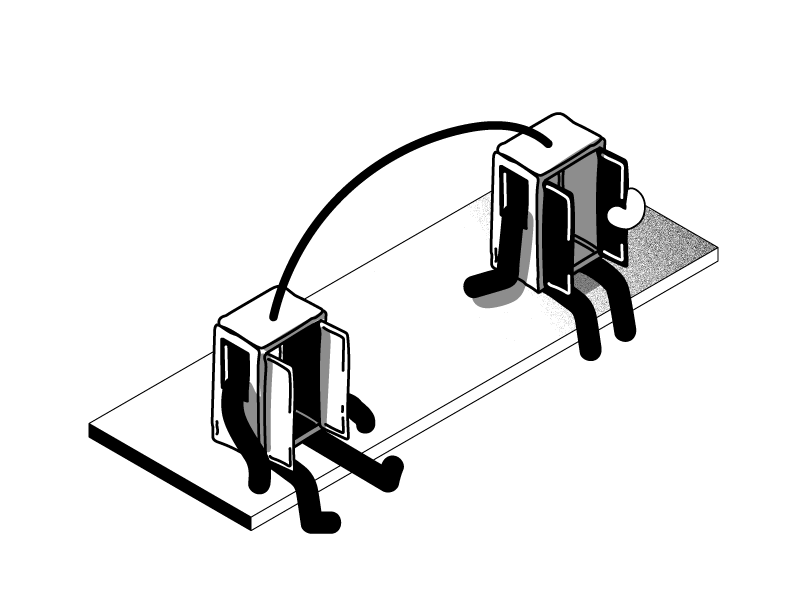
Client Communications Checklist: For voice actors working with clients
The Client Communications Checklist is designed to help voice actors successfully communicate with clients in a variety of situations. Each section is a combination of first-hand experience, insight and advice, with bonus templates that you can copy and paste when working with clients.
What does a client really want from a voice actor?
It’s a question that voice actors puzzle over during pre-audition preparation to post-booking confirmation.
What does a voice actor really need from a client?
And this is a question clients tend to muse over during the script-writing phase, all the way to audition follow-ups.
These are two commonly asked questions when working with clients and voice actors.
The answers to both questions are pretty simple.
For a client, it’s about finding a voice actor that sounds like the voice in their head. A voice actor who is professional, fits into their budget, is easy to work with, and takes direction well. In other words, they want great value with quick, reliable, and accurate service.
For a voice actor, it’s about having all the information. Where will the recording be used, what should it sound like, when does it have to be delivered, and can the client’s budget fit into their rates?
That’s why the most common reasons that cause project delays are a lack of openness, transparency, and information. Working with clients becomes like sitting behind someone at a drive-through. You’re really hungry, but they have no idea what they want to order. Or it’s like asking someone for more information on a product. Then watching them painfully um and er their way through the catalog.
What do we know about this?
Well, we’re taking our research and experience and turning those insights into valuable checklists.
Since January 2021, our customer success team has received almost 70,000 support requests from users who need real-life assistance in real-time. At the same time, we’ve also hosted approximately 48,000 sent messages and 6000 bookings through the Voice123 platform. To bring it all together, we’ve revamped our Voice Over Guide with interviews, discounts, and helpful advice for those who want to get started or practice voice acting.
So whether you’ve just signed up for a Voice123 profile or been a member for years, we’ll walk you through our exclusive insights. This will give you an A-Z of working with clients and maintaining speedy, open, and effective communication channels.
What you need to know to successfully quote and negotiate as a voice actor
At the end of this section, you’ll be able to quote and negotiate like a pro!
Before you can begin working with clients, you have to first get a foot in the door.
This is usually done by auditioning for projects or uploading voice over samples to your online voice actor profile or website.
Since this is the first stage, it’s often the most time-consuming. It often requires a good deal of back and forth communication. It’s also where voice actors run into the commonly asked question, ‘how much should I quote?’
This is not about choosing a random number as there are many facets to consider such as usage and industry rates.

Then, what if a client likes your audition or voice over sample but offers a lower price than what you quoted? This creates another communication challenge as a voice actor needs to know, ‘how can I negotiate?’
At this point, it’s good to keep in mind that low rates are not always a case of a client trying to lowball a voice actor. Sometimes, they’ve simply been given a number that they have to work with. And realistically, not all budgets can be negotiated. So it’s important to know how flexible you are, what kind of discounts you can offer, and what base rates are non-negotiable.
That being said, what information do you need to know before you decide to take on a new client? And what are the best ways to quote and negotiate?
We’ve compiled our findings and insight in the full post What you need to know to successfully quote and negotiate as a voice actor, which you can read on Anne Ganguzza’s website.
How to be really successful at live direction
This section will show you how to ace your next live session!

After obtaining the necessary information and locking in a budget, the next stage of the project is to prepare for your voiceover. Then deliver your very best performance!
Now, clients are busy people, there are no two ways around that. But you still need certain information in order to nail their brief. A quick way to save time is by having a list of points you need to cover before getting started.
One of these points is how the client will direct your delivery. Some clients provide detailed notes on tone and style. But with key world events changing the scene of things, clients and voice actors are both realizing the value of live direction. Although, this can also bring its own challenges related to terminology, body language, questions, and misaligned expectations.
Remote or live direction can also portray the idea of having a client watch over your shoulder and nitpick your performance. And even though that’s not the case among professionals, what should you do if a client wants to direct your performance? How can you also educate the client on acting terminology to ensure you’re both on the same page?
Then, during the live session, how should you ask questions? And how can you show that you’re really listening to the answers?
Check out our full findings in the post, How to be really successful at live direction on J. Michael Collins' website.
How to best communicate with a voice over client
This section will delve into the nitty-gritty of how you can avoid miscommunications when working with clients.
‘I wish I could delete that!’
At some point in your communications, you’ve probably had that panicking thought after sending the wrong message to someone. Or maybe you had a typo that changed the context of your message negatively. While this does occasionally happen, sending the wrong message to a voice over client could have serious consequences!
This is why when working with clients, you have to be extra careful of what you say and how you say it. Understanding why you should ask something is just as important because the slightest miscommunication can cause things to spiral out of control.

Since most communication is written, extra care has to be taken to avoid misunderstandings, causing offense, or sending messages that can be misconstrued. It’s also vital to be aware of cultural and time zone differences.
Now, if written communication doesn’t come naturally to you, we’ve got you covered! The free Client Communications Checklist Collection has relevant, new, copy and paste templates so you don’t need to worry about backspace or delete.
But, how can you maintain a good communication flow throughout the entire project? What does it mean to be responsive? And what are the 3 Ps that you need to have in order to achieve open and successful communication?
Check out our full findings in the post, How to best communicate with a voice over client on Laura Schreiber's website.
Useful tips to get recurring clients
This section highlights useful tips and best practices to help you create top-of mind-awareness for your personal brand as a voice actor and get you repeat work.

Working with clients can sometimes feel like walking a tightrope.
One wrong move and you can slip and fall. Thus, one delay or misunderstanding can grind a great voice over project to a standstill.
So, is repeat work even possible when working with clients? Well, it’s like why people use the same manicurist, barber, or go to the same car wash. When something works, you stick with it, because you expect the same satisfying results every time. That’s why clients often use the same voice actor or add them to a trusted roster.
Naturally, you’re wondering how you can achieve this kind of career stability. Should you leave it up to fate, or hound your clients until they give you another job?
Definitely neither.
When working with clients, you need to show that you’re a professional by allowing a natural network to build with a slight nudge here and there.
But then comes the internal struggle of “what should I say?”
‘How did the project go?’ No, that’s too fake.
‘Do you have any other projects I could audition for?’ No, that’s too blunt.
This is why we’ll be adding more templates you can copy and tweak in our free Client Communications Checklist Collection.
What about how many times should you follow up? Is there a rule of thumb? Will clients think you’re annoying if you send a follow-up, or rude if you don’t?
Truth be told, there’s no simple answer. It depends on each client and project. But there are certainly industry-recommended practices you can follow to secure recurring clients.
Read our findings and expert advice in the full post, Useful tips to get recurring clients on Kim Handysides’ website.
What you need to know to create successful voice over contracts
This section is packed with industry tips and advice for the best voice over contracts.
It’s often said that a little knowledge can be a dangerous thing.
That can be especially true when it comes to running a voice over business and arranging payments and invoices. In this case, a little knowledge would be a client offering a price and a voice actor agreeing to it. But more information and actions are needed. And usually, it’s the voice actor who has to ensure that both sides fully understand and agree to the payment terms and method.

Understandably broaching the topic of payment can sometimes be awkward, but let’s put it into perspective.
Apple invests billions of dollars into their technology, but do they ever hand out free iPhones? And have you ever seen a ‘free sneakers’ sign on any Nike store window?
Well, as a voice actor, you’ve provided a service and invested your time and resources. You need adequate compensation.
This is why it’s helpful to have a voice over contract that specifically lays out how the invoice will be sent, what details are required from both sides, when the payment will be made, and which payment method will be used.
Now, the phrase voice over contract can be intimidating, especially if you’re unsure of what it really means. Is it a long, ten-page contract that legally binds a client and a voice actor? Or is it simply an email, message, or perhaps even a service agreement?
Learn the answers to these and other service agreement questions in the post, How to Create Successful Voice Over Contracts (Service Agreements) on Actors' SOUND ADVICE.
Here's how to best protect your voice over work
This section guides you through practical, step-by step ways to protect your voice over work without negatively impacting client relations.
“Hey! That’s mine!”
Have you ever said that to a friend who thought they could slip away with your favorite hoodie? Or to a colleague who picked up your phone instead of theirs? That’s because the keyword in that phrase is ‘mine.’
When something belongs to you the need and desire to protect it is innately strong. Regardless of whether it’s a book, hoodie, phone, or especially a voice over recording. That’s why when working with clients, you need to take adequate precautions to ensure the protection of your voice over work. But this is something of a catch-22; while the voice over work is yours, the client commissioned it, provided the script, and is paying for the usage of it.
This is why protecting your voice over work is a two-step process. First, during the audition stage, you have to decide if you need a suitable audio watermark. Second, you need to protect the final version by means of a detailed service agreement.
But how can you know which audio watermarks are suitable and won’t hinder your chances of getting hired? And how can a service agreement prevent unauthorized use of your voice over recordings when working with clients?
How to be successful when working with clients
In these six sections, we’ve worked together with some of the most experienced voice over experts to equip you with the know-how, do’s and don’ts, and practical templates to ace every project, every time!
So, what do you need to keep in mind when working with clients?
When quoting and negotiating, follow industry rates, best practices, and be transparent and confident when negotiating. To ace live sessions, listen to the client’s instructions and feedback carefully. Be cooperative and keep in mind that the client is always right.
To best communicate with a voice over client, prepare your communications ahead of time, follow the right format and tone, and always strive to be Professional, Punctual, and Polite.
What about useful tips to get recurring clients? Well, you have to be the one to take charge by following up, avoiding miscommunications, and doing your best to anticipate a client’s needs. And by striving to keep this in the back of your mind when working with clients, everything you say and do in a project or booking will create top of mind awareness for your voice over brand!
To create successful voice over service agreements, keep it professional, triple-check everything, and always establish your terms in advance. And finally, to best protect your voice over work, you need to take certain precautions, outline your T&Cs in a service agreement, and take the initiative to inform yourself. Avoid being suspicious of every client but do put the right measures in place to protect your voice over work.
Together with voice over experts, we’ve created a living, breathing document full of message templates that you can copy and tweak in your own client communications.
Boost your voice over work opportunites with a paid Voice123 membership
First-time paying members are eligible for a discount
Share this post!
A blog owner yourself? Relevant links to quality sites will help your performance on search engines. If your readers will benefit from the services or information on The Booth's Voice over Guide, please consider linking to this post or the guide itself.


